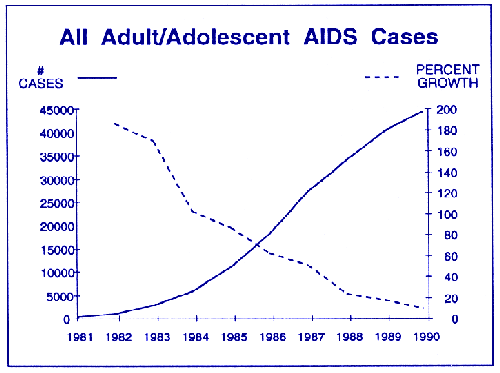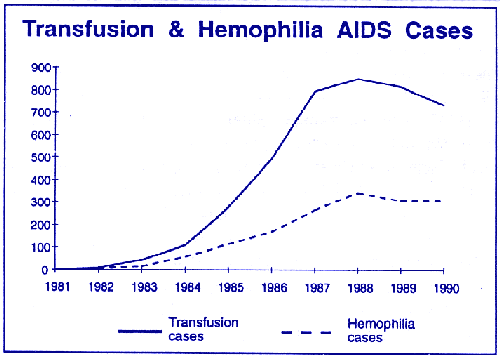AIDS IN THE U.S.: A GROWING EPIDEMIC? Robert Maver
Rethinking AIDS Aug. 1992
The following analysis is based on AIDS cases reported to the Center for Disease Control (CDC) through December 31, 1991. In order to obtain a clear picture of the growth of the epidemic, cases must be viewed by diagnostic year. This is accomplished by analyzing the lag between the date an AIDS cases is diagnosed and the date it is reported to CDC. A series of "lag completion" factors can be generated from an analysis of prior lag patterns. For example, by the end of 1991, virtually all cases diagnosed prior to 1987 have been reported. On the other hand, based on prior years' actual runout, we can expect approximately 20% of cases diagnosed in the 4th quarter of 1990 are still unreported.In the exhibits that follow, actual cases reported by diagnostic year have been increased by "lag completion factors" to reflect expected ultimate reporting. So much of 1991 diagnoses remain unreported that 1990 is me last year used.
The most elementary evaluation of the growth of the epidemic entails solving for the annual growth rate. The growth rate is the number of cases diagnosed in the current year divided by the number of cases diagnosed in the prior year. Converting these numbers to percentages (as sbown in the graph), one can readily see that the growth rate of the epidemic has decreased every year since 1982 and is approaching zero. The inevitable conclusion is that the epidemic is cresting, and the number of cases diagnosed will begin to decline. This can already be seen in certain patient risk groups.
The homosexual AIDS cohort, which accounted for 55% of all cases diagnosed in 1990, is shown in the accompanying graph. When all cases are counted, the cohort is seen as approaching a crest. However, when only those homosexual AIDS cases meeting the more limited 1985 definition are counted (which provides consistency throughout all diagnosed years), the crest is clearly seen in 1990. The expanded definition has added 38% more cases in 1990 and delayed the epidemic's crest.
Graph 3 shows that the hemophiliac cohort and the blood transfusion cohort both crested in 1988. This is a most curious result.
"Evidence from several studies indicates that exposure to HIV began in 1978 for the U.S. hemophiliac population and that 70-85% of this population had been infected with the virus by the end of 1984, most becoming infected in 1981-82" (McGrady, et al., 1987, American Journal of Epidemiology, 126:25). The U.S. hemophiliac population was estimated to be 14,467 as of 1980 (National Heart, Lung and Blood Institute, DHEW pub no. NIH 77-1274). This equates to about 11,000 HIV+ hemophiliacs, infected for 10 years, only 1,713 (15.6%) of whom developed AIDS. The median incubation period implied by these statistics begins to approach 25 to 30 years. This is tantamount to saying that for a significant percentage of hemophiliacs, HIV infection does not lead to AIDS, because the incubation period exceeds the life expectancy.
lt is estimated that 12,000 transfusion recipients were infected with HIV in the early 1980s before regular screening of the blood supply was implemented (Ward et al., 1989, NEJM, 321:947). Through 1990, about 35% had been diagnosed with AIDS. This would imply a 10 year median incubation period. Perhaps the more interesting observation with respect to transfusion AIDS is that HIV seropositivity does not appear to confer increased mortality. A 1989 study by Ward and colleagues at the CDC, designed to ascertain whether HIV increases risk of death after transfusion, reportcd that "of 233 recipients [HIV+ transfusion cases] whose medical records were located, 95 (41%) had died within one year of transfusion .... By comparison, 73 (50%) of 146 recipients of components from a random selection of donors not known to be infected with HIV died in the year after transfusion" (Ward et al., ibid.). Thus transfusion cases with HIV actually had; better mortality than transfusion cases without HIV (41% vs. 50%).
The intravenous drug user cohort evidences the same pattern as the homosexual cohort, but is less mature and thus funher from its crest. And the heterosexual cohon is the least mature of all. The growth rate in this cohort has decreased every year, but the growth rate in 1990 is still a substantial 39%.
Along these lines, it is of interest to note that heterosexual AIDS remains virtually nonexistent among teenagers. There have been only 5 cases ever reported of teenage male heterosexuals contracting AIDS through sexual activity (1 case in 1990 and no cases diagnosed in 1991), and only 89 female cases (26 cases in 1990 and 13 diagnoses so far in 1991).
It is difficult to reconcile estimates of HIV infectivity with the above analysis of AIDS cases. One reason is that the CDC changes its estimate of HIV prevalence retroactively. e.g., in MMWR Vol. 38/No. 5-4 (May 12, 1989), CDC said, "Thus, while variable, the observed HIV antibody prevalence data are compatible with CDC's 1.0 million - 1.5 million working estimate, particularly with the lower end of the range." Then, in MMWR Vol. 39/No. RR-16 (November 30, 1990), "CDC now estimates that approximately 750,000 persons in the United States were infected with HIV at the beginning of 1986." They also estimated HIV infections as of Juy 1989 at "approximately 1,000,000."
These CDC estimates are based largely on back-calculation methods. Back-calculation assumes that the incubation curve is known and that the epidemic's curve is known (from reporting of actual AIDS cases). Thus, one can solve for the implied HIV infection curve that produces the incubation period assumed and the number of cases actually materializing. It is apparent that if one changes the incubation assumption, HIV prevalence changes.
The CDC also uses extrapolation from empirical data as a method to arrive at HIV prevalence. Such empirical data include military studies, Red Cross blond donor studies and studies of homosexual male cohorts. Interestingly, a pilot survey of Dallas County, Texas in 1989, designed to measure HIV prevalence in the general population, did not corroborate the back-calculation models used by CDC. In fact, even after adjusting upward to reflect non-response bias, the survey estimated HIV infections at a number 50% to 70% lower than three back-calculation models. Similarly, data from the six pilot sentinel hospitals, which are located in cities that in the aggregate have an HIV prevalence in applicants for military service of approximately the national average, show a median prevalence of .24%. This would translate to 600,000 HIV infections in the U.S. general population of 250,000,000.*


